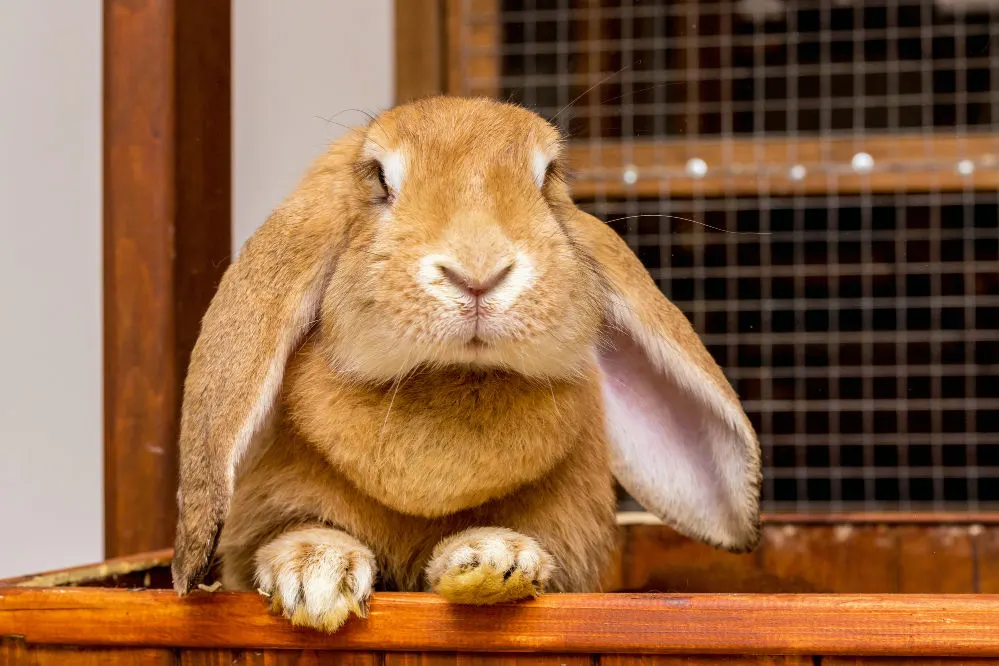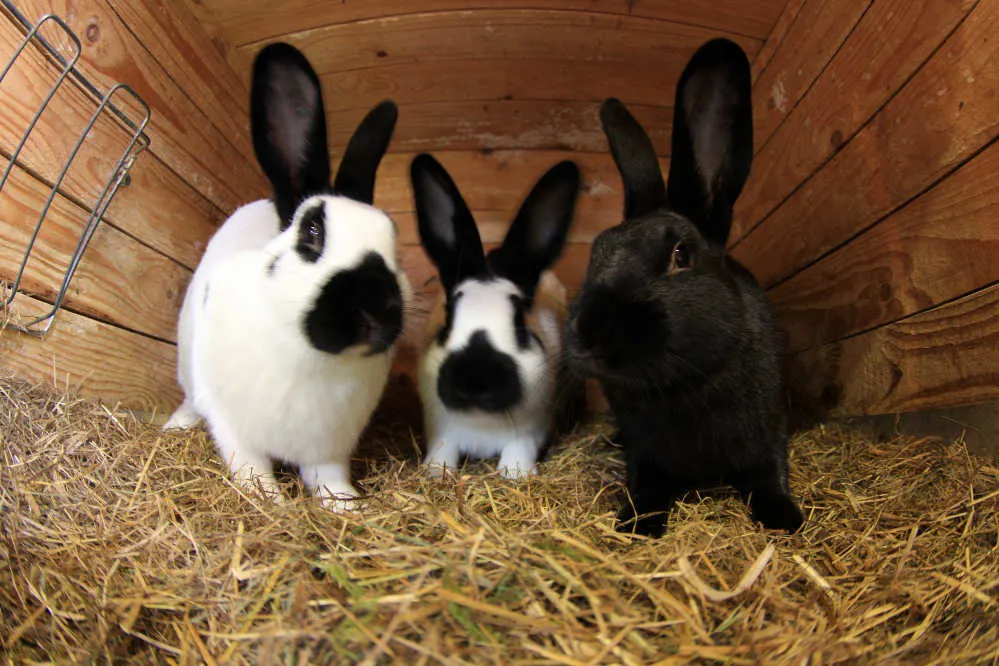Rabbits, the fun-loving, fuzzy companions, are always a source of joy that many owners can attest to. You undoubtedly want what is best for them, especially their comfort and safety.
Many of the best indoor rabbits (and outdoor rabbits, actually) are accustomed to sleeping in enclosures, but choosing the best set-up for the cage is often challenging. That’s why, as pet owners, you’re surely wondering what to put in the bottom of a rabbit cage.

If so, look no further. This guide will take you through the ins and outs of your furbaby’s cage flooring and will give the ten best bedding options for rabbits.
Why do you need to put something at the bottom of your rabbit’s cage?
First things first – why do you even need to use bedding? Well, rabbits (as loveable as they are) can sometimes be messy. They eat and chew on things, but most importantly, they tend to do their business wherever they go.
Sure, some rabbits can learn to use a rabbit litter box, but that isn’t always possible. That is where the right flooring and bedding come in. The right bedding can absorb waste, keep odors at bay, and make a more comfortable space for your little friend.
That isn’t the only reason, though. Bedding at the bottom of a rabbit cage also helps with insulation and keeping your rabbit warm during colder days or at night. You wouldn’t want them to get cold, now would you?
What do you put in the bottoms of a rabbit cage?
The type of flooring or bedding that you use at the bottom of your rabbit’s cage depends on a few factors. Is the bedding soft and comfortable? Is it non-toxic and safe for them in case they nibble on it?
Generally, the best type of bedding all share the same characteristics. The type of flooring you use, first and foremost, should be non-toxic. That goes without saying, but you shouldn’t use any chemical-packed materials that could cause potential harm to your pet rabbit.
Secondly, the bedding should be an absorbent material. As mentioned, rabbits tend to do their business in the cage wherever they feel free. The material you use should be able to soak up excess waste and odors that might mess with your little hopper’s comfort.
Finally, the material you use should be edible or, at the very least, safe for your rabbits to nibble on. Rabbits need to chew — it’s in their nature. So, they tend to chew on the bedding of their cage, which is why a safe-to-eat material is best.
The rest is up to personal preference, what you have on hand, and the type of cage you use.
The 10 best choices for bedding to put at the bottom of a rabbit cage
Now, let’s get into the fun stuff. What materials are best for putting in the bottom of a rabbit’s cage? Luckily, you have plenty of options, each with its advantages and disadvantages.
Either way, this list is an excellent place to start. Here are 10 of the best safe options for your furbaby to make their home a little extra homey.
1. Hay
The first bedding material on the list is hay. This sweet, freshly-scented dried grass is one of the best bedding options for your little rabbit. It has all the qualities for suitable flooring — it’s soft, absorbent, and will eliminate all of those odors, but most importantly, it is safe to eat.
Think about it — what should rabbits eat? According to the RSPCA, they need a whole bundle of grass and hay daily to keep them sustained and healthy. So, not only is hay safe for them to eat, but it is also necessary. It gives plenty of fiber that rabbits thrive off of.
Of course, you will have to change out the Timothy hay (the best option) quite often, but this bedding option is a good, all-natural choice.
2. Straw
Straw is another great, all-natural bedding option for the bottom of your rabbit’s cage. Similar to hay, eco-friendly straw is very absorbent and can trap any liquids if your bunny makes a bit of a mess. More importantly, straw gives good insulation, so your furball can stay warm and snug all day and night.

Straw is also an edible and safe-to-eat option. It isn’t, by any means, as nutritious as hay, but it definitely won’t do any harm. Just make sure that you change it out when necessary.
3. Paper
If you recycle and reuse old materials, then paper-based bedding might be great for your bouncing companion. Not only is it some of the best bedding for guinea pigs, but it works just as well for rabbits.
Paper can make excellent bedding in rabbit hutches when shredded. It’s absorbent, easy to come by, and safe to nibble on for the most part. Do be wary, though. You should steer clear of paper with too much writing or print. The excess chemicals in the ink could cause an upset tummy for your furbaby.
4. Wood shavings
Next up on the list is wood shavings. This is pretty good as bedding for your rabbit, especially for the bottom of a wire cage.
The most common type you’ll find at a pet store is aspen wood shavings, which are sometimes considered the best. They are highly absorbent and help with odor control. They also happen to be free of toxins, unlike some variants like cedar or pine, which could lead to gastrointestinal problems in rabbits.
5. Bunny-safe litter
Bunny-safe litter is a good option for getting complete coverage of the floor of your rabbit’s enclosure. It isn’t the best option for warmth and comfort, but it is more suited for easy cleaning and keeping the space free of smells.
Using a mixture of this and another type of bedding might be the best route to take. This way, you can be sure your rabbit has a mix of comfort and cleanliness.
6. Sisal rug
This next option is good for convenience. A sisal rug is another natural option that is considered safer for those rabbits that tend to chew a heck of a lot. They are less likely to ingest tiny pieces of fibers because this rug is so durable.
These rugs are non-toxic, absorbent, and can be easily removed from the cage to wash. Although, sometimes, they may be considered a little too hard and could damage your rabbit’s teeth — so check on them often to see if they’re chewing more frequently than usual.
7. Blanket or towel
There’s nothing cuter than seeing a little bunny snuggled up in a fluffy blanket, is there? Whether you have fleece blankets for bunnies or an old towel, they make for some of the most comfortable bedding a bunny could want.
Like litter, blankets or towels are best used in conjunction with other types of bedding, especially if your bunny tends to nibble a lot. They’re also reusable after a good wash, so it’s a real win-win for you and your bun-bun.
While this flooring option is undoubtedly warm and comfy, it is best used when your bunny spends most of its time outside the cage. So, having a section of the cage with a blanket or towel to keep them cozy is just fine. Your furry friend will love to snuggle up.
8. Wood pellets
Wood pellets are another popular option for pet owners and their rabbits. You can find these at any local pet store for a reasonably affordable price.

Wood-based pellets are dust-free, highly absorbent, and an easy option for your rabbit cage floor. Plus, it eliminates the nasty wee smells that neither you nor your furball enjoys. And they double as a great choice for their litter tray.
9. Grass-woven mat
Now onto the little sister, so to speak, of the sisal rug — the grass-woven mat. This is another great, all-natural, and convenient option to line the bottom of your rabbit’s cage. They are easy to remove and clean and have plenty of benefits.
First and foremost, they keep your rabbit warm by providing good insulation. They also offer good traction so your bunny can comfortably hop along the mat. It is also very absorbent and non-toxic, making it one of the safest options.
The only downside is the price. These can sometimes be very expensive, but you won’t regret the investment — especially if it makes your bunny’s new home perfect.
10. Cardboard
Last but not least, cardboard. You’ve probably asked yourself several times, is cardboard safe for rabbits? The answer is yes — as a floor choice especially.
Cardboard is another one of those affordable options for rabbit bedding and one that you most likely have on hand. It is best to shred this up and ensure the cardboard is free from any metals, residue, or sharp edges.
Cardboard can be very absorbent and a great way to entertain your rabbit. Although, always be mindful of how much your bunny is nibbling away. Ingesting too much cardboard might lead to tummy issues.
What are the flooring needs for cages with wire floors?
The first type of cage you might have for your rabbit is one with a wire bottom. Usually, these cages have a tray underneath to catch any droppings or waste that might fall through. However, sometimes this isn’t the case, and you’ll need flooring or bedding to prevent this.

Even with a tray underneath the wire cage, you still need the right bedding to keep your rabbit comfy. Something soft and plump that will stop them from hurting their little paws on the wires of the cage. Besides, can you imagine how uncomfortable it is for a rabbit’s feet when walking on a wire grid?
What are the flooring needs for cages with solid floors?
Cages with solid bottoms are slightly different from wire bottom ones. This cage type is already built to catch waste and droppings at the bottom, so it is easy to clean, so that should be a breeze.
You don’t have to worry that much about your bunny hurting its paws. After all, the solid bottom is undoubtedly easier to walk on. Comfort must play a role, so soft bedding is always a good idea.
However, the main priority for a solid floor rabbit cage is absorbency and odor control. If the bedding you choose has those two properties, then you’re ready to go ahead.
What to put in the bottom of a rabbit cage | Wrapped up
So, there you have it — the best rabbit bedding options for your furbaby. Making sure your rabbit is always well taken care of is your top priority, and now you know more about what is suitable for their enclosure.
While all of these are good options, always consider the size of your rabbit cage and even the size of your bunny. Do you know how big Flemish giants get? The needs of larger breeds will undoubtedly be different from a smaller Netherland dwarf.
But in the long run, you know your furball the most, and you will always put your best foot forward, giving them the best treatment you can.
Steph Dyson is a travel journalist by trade but a lover of all small pets. She’s been a pet mum to everything from gerbils to guinea pigs, rabbits to hamsters, and fish to dogs of all shapes and sizes. She wants to share her years of experience with small pets and make Small Pet Guides the go-to website for pet owners seeking information and care advice.

